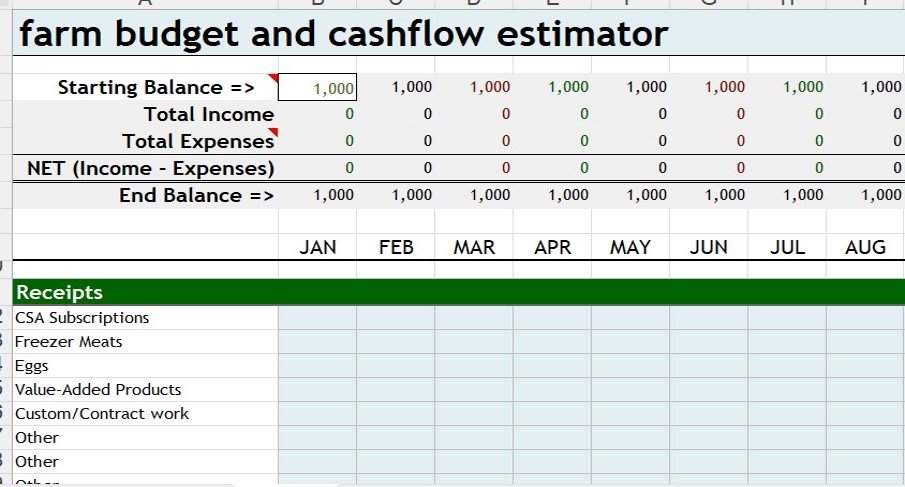How small farms can increase net farm income
First, the bad news: for the last couple of years, Statistics Canada has reported a decline in net farm income. And the USDA reports that, in recent years, roughly half of farm households have had negative farm income each year.
It seems that income declines or remains stagnant while expenses continue to rise. Can a small operator take steps to increase his/her income? Definitely YES: this is the good news part.
Before we talk about increasing income, you need to understand where you are now. For that, we need a little background in common financial definitions and formulae.
The section below is from Module 5 of my Bootstrap Boot Camp course.
Financial terms and definitions
Fixed costs: Fixed costs remain relatively stable regardless of how much you sell. These are the costs necessary for you to produce your product from beginning to end and incur whether or not you sell anything. For example: tools, equipment, vehicle, office, land.
Variable costs: Expenses directly related to output i.e. consumable supplies, packaging, wages, seeds, feed, etc. Variable costs change with levels of production.
Mark up: Percentage of increase over cost price. Industry standards for retail pricing markup is 60% however, you may need to adjust your percentage based on the reality of your costs and competition.
Gross Profit: sales minus all costs directly related to those sales. For example, I sell a product for $150, and my costs are $90, my Gross Profit is $60.
Gross Profit Margin: Gross Profit ÷ Total Revenue. Using the above example: $60 Gross Profit ÷ $150 Total Revenue = 40% Gross Profit Margin
Break Even Point: Fixed Costs ÷ (selling price per unit- variable costs per unit)
For example, let’s say my fixed costs for my market garden come to $8,000. I decide to sell CSA shares for $1000, and I estimate my variable costs to be $600 per share. I would need to sell $8,000 ÷ ($1000 - $600) = 20 shares to break even i.e. cover all my costs.
These terms are important to understand when you are figuring out your current net farm income.
Here's another important one:
Net Income ÷ (1 – your tax rate) = Gross income.
Example: If you estimate you need $3,000/month to live on, after tax, and your tax rate is 25% then:
$3,000 ÷ (1-25%) = $4,000 Gross Income required each month, or $48,000 annually.
So, to wrap up this part, how much typically do small farms get to keep for each dollar of sales? Here's a table with some examples of gross and net farm income per acre for various sizes of farms.
 Synopsized from a study 'Grower to Grower', John Hendrickson, UW-Madison Center for Integrated Agricultural Systems
Synopsized from a study 'Grower to Grower', John Hendrickson, UW-Madison Center for Integrated Agricultural SystemsMy experience says net cash to gross is typically around 40% for small mixed farms. Joel Salatin of Polyface Farm says that every $150,000 in sales produces one full-time income for one person.
This can be a sobering realization for the small farmer. I sometimes guest-lecture to an Urban Ag class at a local community college. I do a net farm income example for them using the numbers shown above.
You need $3,000/month to live on ÷ (1-25%) = $4,000 Gross Income required each month, or $48,000 annually.
If you take a net cash to gross of 40%, that mean you need $120,000 annual sales to put that $3,000 cash in your pocket each month.
So, what can you do to increase net farm income?
Since (as James Altucher says) I don't do advice, I do autobiography, here are a handful of things I've done to increase farm income.
1. Adopt a CSA Model. Community Supported Agriculture (CSA) is a good model for the small operator. In the table above, the highest net incomes were achieved by CSA farms. That has been our experience, as well as several of our local farming friends. You can download my Free Guide to starting a CSA organic market garden by filling in the form below.
2. Sell more to the same customers. The cost to sell more products to customers you already have is much less than the cost of acquiring more customers. We sell more farm goodies - eggs, beef, pork, chicken, lamb - to customers who originally joined our CSA just to get veggies. Usually all these items are pre-sold before the season even begins.
If you manage it right, these additional farm products won't result in a lot more work.
3. Give e-commerce a try. One of the few work-at-home schemes that actually works is to create an income-producing e-commerce website. A working website can be a valuable asset and help you increase farm income even while you sleep.
Free CSA Market Garden Guide

The consumer demand for fresh local organic food has never been higher. Bad news on the supply chain is good news for local growers.
Get my free Organic Market Gardener Start-up Guide and see if this is the right time to launch your CSA market garden business. Download it here.
Download more free reports here
- Home Page ›
- 5 Acre Farm ›
- Farm Income





